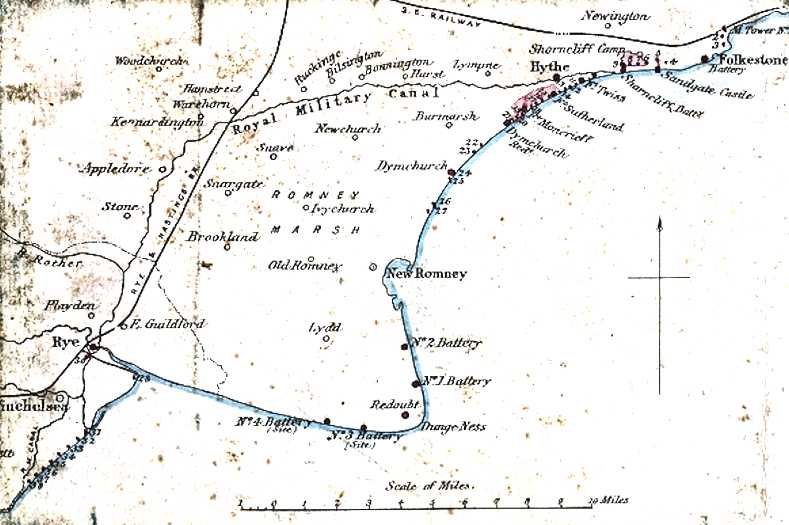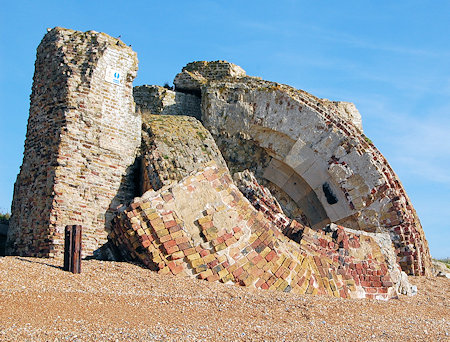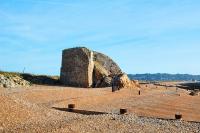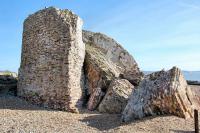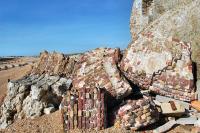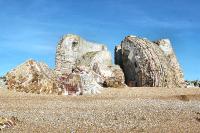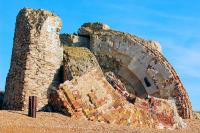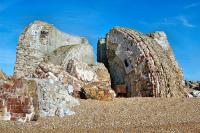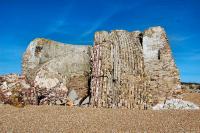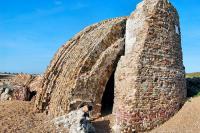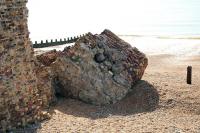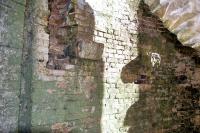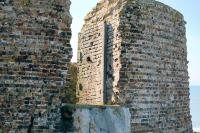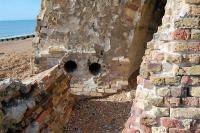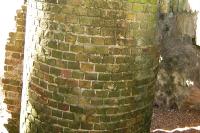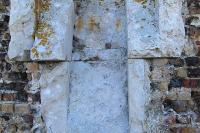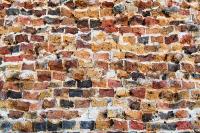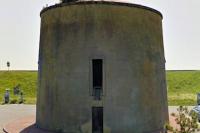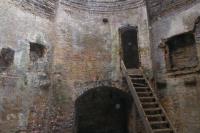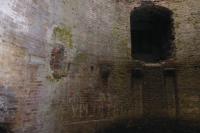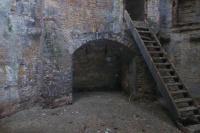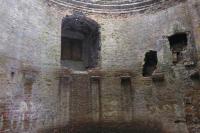Martello Towers

century, from the time of the Napoleonic Wars onwards. Many were built along the coast of Romney Marsh to defend Britain against the French in the early 1800s, then under the rule of Napoleon Bonaparte.
![]() Introduction
Introduction
![]() 1867 Map of the Martello Towers
1867 Map of the Martello Towers
![]() Origin & Purpose of Martello Towers
Origin & Purpose of Martello Towers
![]() Description of Martello Towers
Description of Martello Towers
![]() Martello Towers on Romney Marsh
Martello Towers on Romney Marsh
![]() Wars with France
Wars with France
![]() Pictures of Towers in the Past
Pictures of Towers in the Past
![]() Photo Galleries
Photo Galleries
![]() Visit a Martello Tower in Dymchurch
Visit a Martello Tower in Dymchurch
![]() More About Martello Towers
More About Martello Towers
![]() Dymchurch Redoubt
Dymchurch Redoubt
![]() Books about Martello Towers
Books about Martello Towers
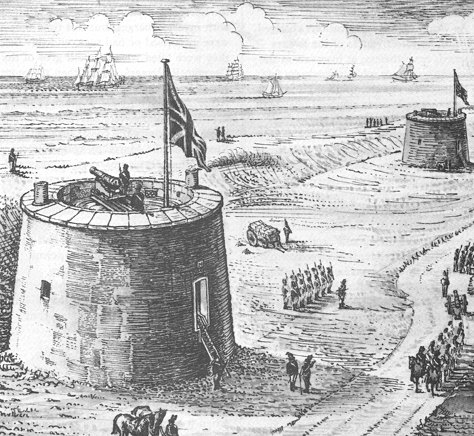
Artist's impression of two garrisoned
Martello Towers on the Kent Coast

Martello towers were built, at great cost, along the coasts of Kent, Sussex, Essex and Suffolk at the time of the Napoleonic wars. Originally, there were 103 of these 30ft-high towers, with walls 13ft thick and roof-mounted cannons capable of shooting lead balls a mile out to sea.
Given that Romney Marsh was only some 30 miles from Boulogne on the coast of France just across the English Channel where Napoleon Bonaparte had amassed his Army and invasion fleet (find out more), it was one of the areas that was most at risk from invasion by Napoleon's forces.
Originally 103 towers were built between 1805 and 1812, 74 were built along the Kent and Sussex coastlines from Folkstone to Seaford between 1805 and 1808, the other 29 to protect Essex and Suffolk. 45 of the towers still remain, but many are in ruins or have been converted, so only 9 remain in their original condition.
Along its coastline from south of Hythe to St Mary's Bay, there were nine Martello Towers and one Redoubt. Towers Nos. 19, 20, 21, 22, 26 and 27 have since been demolished, but Towers Nos. 23, 24,and 25 and the Redoubt remain in Dymchurch.
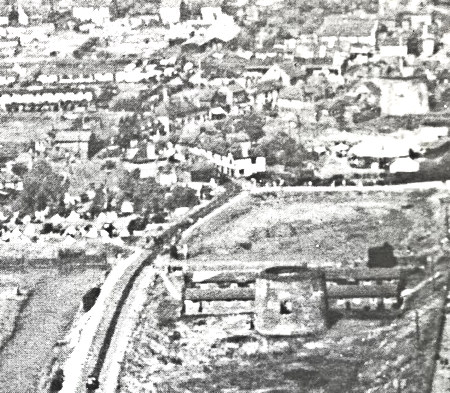
Martello Towers Nos 24 and 25
Dymchurch in 1935
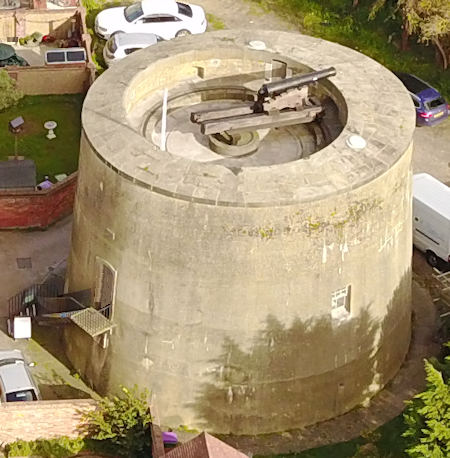
Martello Tower No.24
Open to the Public
Origin and Purpose of Martello Towers
Martello Towers were solid, low and circular, massively built of stone or brick with guns mounted on a flat roof. Their purpose was to provide concentrated fire on ships at sea to repel an enemy landing, and they were capable of withstanding a siege of considerable duration.
A total of 103 Martello towers were built in England, set at regular intervals along the coast from Aldeburgh in Suffolk, around Kent to Seaford in Sussex.
It was summer 1803 when a Captain William Ford and local General Sir John Moore proposed a scheme of small towers as a defence against Napoleon. This was not the first kind of tower used as a fortification. Towers were already being built around the Mediterranean to combat piracy and protect naval positions. Ford got his idea from a French structure tower (see picture right) on the Isle of Corsica, ironically the birth place of Napoleon. The tower was situated at Mortella Point in the Bay of Fiorenzo. It was armed with one six pounder and two eighteen pounders.
On 7 February 1794, two British warships, HMS Fortitude (74 guns) and HMS Juno (32 guns), unsuccessfully attacked the tower at Mortella Point. A garrison of 38 defenders with three small cannons withstood an all-out assault from the two fully armed British warships. The tower eventually fell to land-based forces under Sir John Moore after two days of heavy fighting. What helped the British was that the tower's two 18-pounder guns fired seaward, while only the one 6-pounder could fire land-ward.
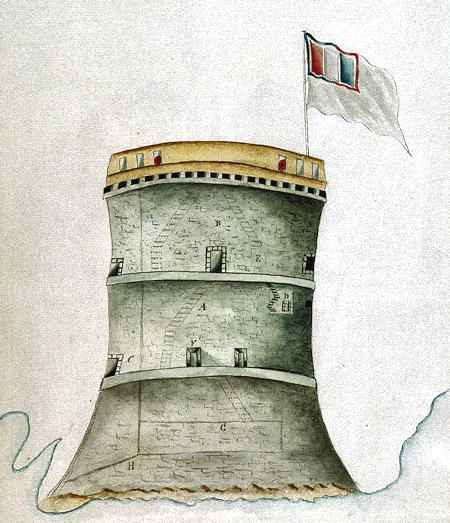
Mortella Tower Corsica 1794
General Moore was involved in this campaign in Corsica and had been impressed by the defensive capabilities of the Mortello Tower, particularly the stout resistance the tower had offered to the British land and sea forces.
Captain Ford's and General Moore's plan was approved in 1804 and William Pitt, who was Prime Minister at the time, laid down plans for the towers. Towers were built from Folkestone to Seaford in East Sussex. Between 1805 and 1812 seventy-four towers were built in all, six of these in Dymchurch and two in St Mary's Bay on the Marsh. See map right below
Included in the scheme were three much larger circular forts or redoubts that were constructed at Harwich, Dymchurch and Eastbourne; they acted as supply depots for the smaller towers as well as being powerful fortifications in their own right.
Description of Martello Towers
The towers were about 40 feet (12m) high with walls about 8 feet (2.5m) thick. Entry was by ladder to a door about 10 feet (3m) from the base above which was a machicolated (slotted) platform which allowed for downward fire on attackers.
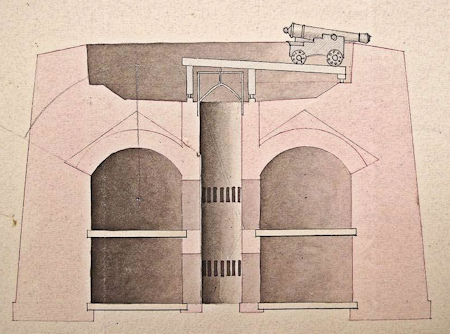
A sectional design drawing of a Martello tower, made in 1804, possibly
by Captain William Ford. Courtesy of the National Archives
The flat roof, which was the tower's gun platform,was covered with lead and surrounded by a solid parapet usually 6ft high and at least 6ft thick. The was a raised platform in the centre with a pivot for a 360 degrees traversing gun or cannon, with the gun being turned by the use of ropes and pulleys. The walls had narrow slits for defensive musket fire.
The walls were made of bricks set in a mixture of lime, ash and hot tallow, which gave them extrordinary strength, with cannonballs bouncing off the walls
The interior of a classic British Martello tower consisted of three storeys (sometimes with an additional basement). The ground floor served as the magazine and storerooms, where ammunition, stores and provisions were kept.
The garrison of 24 men and one officer lived in a casemate on the first floor, which was divided into several rooms and had fireplaces built into the walls for cooking and heating. The officer and men lived in separate rooms of almost equal size.
A well or cistern within the fort supplied the garrison with water. An internal drainage system linked to the roof enabled rainwater to refill the cistern.
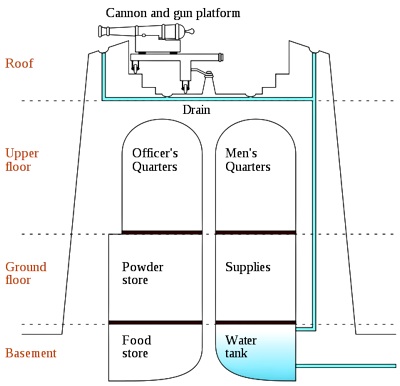
Diagram of a Martello Tower
The effectiveness of Britain's Martello towers was never actually tested in combat against a Napoleonic invasion fleet. The original function of Martello Towers was eventually overtaken by the continued development of artillery.
After the Napoleonic threat had passed, the Martello towers in England met a variety of fates. Many were taken over by the Coast Blockade Service, then the Coastguard, to aid in the fight against smuggling. Fifteen towers were demolished to re-use their masonry. Thirty were washed away by the sea, while four more were destroyed by the military in experiments to test the effectiveness of the new rifled artillery.
During the Second World War, some Martello towers returned to military service to serve as observation platforms and firing platforms for anti-aircraft artillery.
Forty-seven have survived in England, of which a few have been restored and transformed into museums, visitor centres, and galleries. Many are privately owned or private residences and the remainder are derelict. Only nine remain more or less in their original condition, with Martello Tower No.24 having been restored to the actual design and with its own cannon.
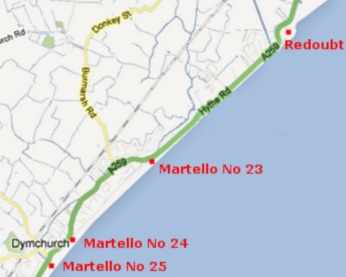
Location of Martello Towers, and Redoubt, still standing
Find out moreForty-seven Martello towers have survived in England, a few of which have been restored and transformed into museums (e.g., the tower at St Osyth), visitor centres, and galleries (such as Jaywick Martello Tower). Some are privately owned or are private residences; the remainder are have been left to deteriorate and become derelict.
![]() Reference and more information
Reference and more information
Martello Towers on Romney Marsh
The closeness of Romney Marsh to the continent, its flat shores and hinterland and easily accessible beaches, has meant that the Marsh has been in the front line whenever invasion has threatened, particularly from across the English Channel. It was, therefore, one of the areas that were most at risk from invasion by Napoleon's forces. Find out more
Along its coastline from south of Hythe to St Mary's Bay, there were nine Martello Towers and one Redoubt. Towers Nos. 20, 21, 22, 26 and 27 have since been demolished, but five of the towers and the redoubt remain.
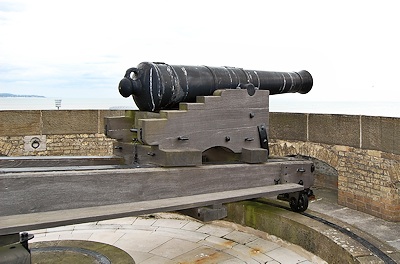
24 Pounder Cannon was the main armanent on Martello Towers
Martello Tower No.19 is located right on the beach to the east of the Hythe Army Ranges. It was built in 1806 but in late 1970 it was undermined by the sea. In the 1960s it was still in reasonable condition and was listed in 1973.
It has now (2018) collapsed but much of it is still recognisable for what it was. NB The tower can only be viewed when there is no firing on the ranges and at low tide.
Photo Gallery Martello Tower No.19
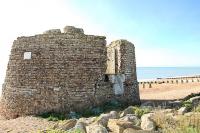
Martello Tower No.22 was located about 2 miles to the north of Dymchurch village. Together with Martello23, it was built to protect the Wiilop sluice - one on the nian drainage sluices from Romney Marsh to the sea - in Hythe Road.
It was demolished in 1956 when the A259 coast road was straightened and widened.
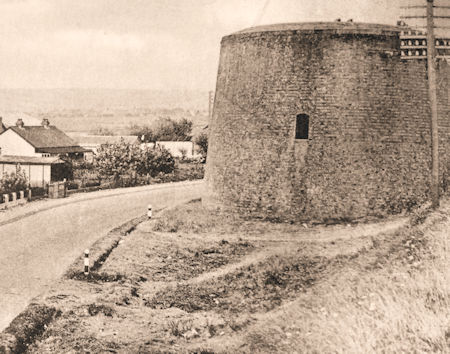
Martello22 before it was demolished in 1956
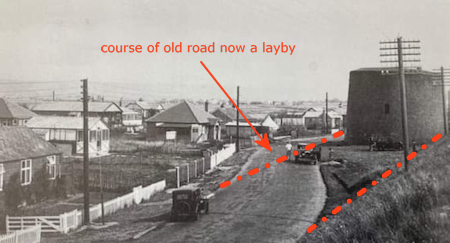
Martello22 showing why it was demolished
Martello Tower No.23 is located on the A259 coast road just outside Dymchurch village. The tower has been restored and converted into a private dwelling in the standard style.
Martello23 was built to protect the Willop Sluice, one of the main sluices helping to drain Romney Marsh. It was paired with Martello Tower No. 22 to the north on the other side of the sluice. Martello22 has since been demolished to make way for road widening.
Originally the ground floor was where the magazine store was located and the first and second floors were the living quarters.
Martello23 has been converted into a home with windows on the top to take advantage of the sea views.
![]() Video of Martello Tower No. 23
Video of Martello Tower No. 23
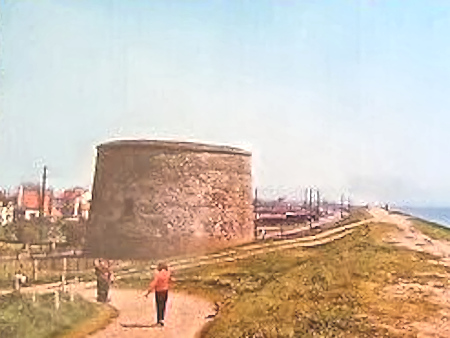
Martello Tower No 23 before conversion to a residential property
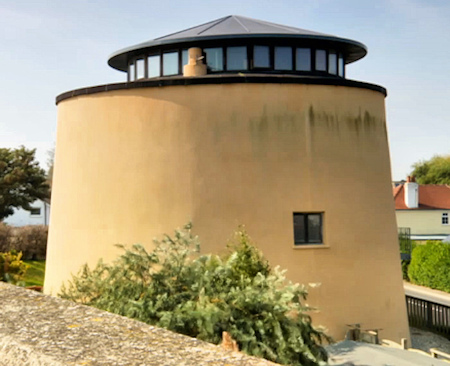
Martello Tower No. 23 in Dymchurch (April 2018)
Martello Tower No.24 is located between Dymchurch High Street and the beach. Together with Tower No.25, it was built to protect the main Marshland Sluice in Dymchurch Road. It has been fully restored and re-equipped with its 24 pounder cannon.
Now an Ancient Scheduled Monument managed by English Heritage, it is only one of three Martello Towers on the south coast that opens to the public.
Find out more on our Martello Tower No. 24 page.
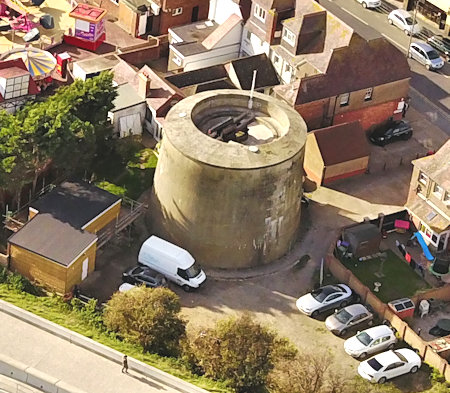
Martello Tower No. 24 in Dymchurch Today
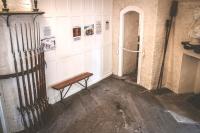
First Floor Today
Martello Tower No.25 is located in the Dymchurch Martello car park just as you enter Dymchurch on the A259 from New Romney. The outside of the tower has been restored but the inside is in a poor condition. It is currently unused and closed up.
![]() See inside
See inside
Previously owned by Folkestone & Hythe District Council and formally used as a cafe, the tower was put up for auction in December 2017. It had a guide price of £70,000 to £75,000 but it was sold to a private buyer for £145,000. The purchaser applied for and received planning permission in May 2019 to convert the tower into a four-storey 4 bedroomed holiday let. As at February 2020, the conversion work had not started.
Photo Gallery Martello Tower No.25
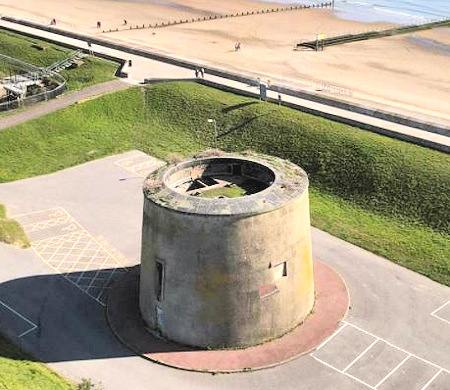
Martello Tower No. 25 In Dymchurch
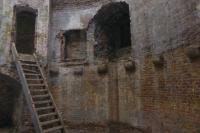
Inside Martello25 June 2019
See more inside, as at June 2019
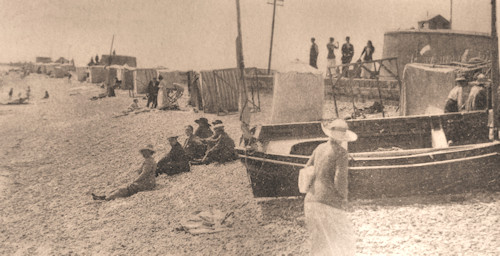
Martello Towers Nos 22, 23 & 24 c1920s
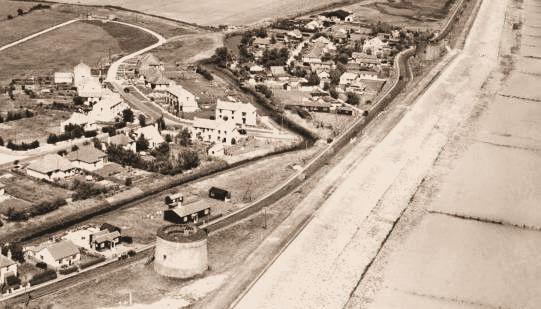
Martello Towers Nos 22 & 23 c1950s
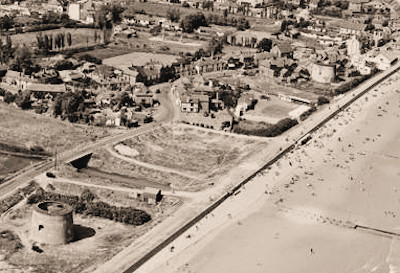
Martello Towers Nos 24 & 25 c1949
Martello Towers Nos 26 and 27 were the first brick-built structures to appear on the St. Mary's Bay shoreline. Tower 26 was built on the eastern side of the Globsden Gut Sluice, which ran into the sea near the present Dunstall Lane. Tower No. 27 was built approximately a quarter of a mile to the west; both were built to protect the Globsden Gut Sluice.
Tower No.27 was used as the headquarters of the Coast Blockade Service in their battle against smuggling from c1816 to 1830, and was the site of the first lifeboat on Romney Marsh in 1826.
Neither tower stands today. Damaged by sea erosion, No. 27 was demolished in 1841 and No. 26 lasted until 1871. The site of Tower 26 was on what is now the sea wall next to the car park opposite Dunstall Lane, roughly in front of where the toilet block now stands.
![]() Full list of Martello Towers built on the Kent and East Sussex Coasts
Full list of Martello Towers built on the Kent and East Sussex Coasts
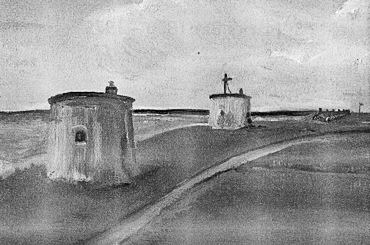
An impression of Martello Towers Nos 26 & 27 in St Mary's Bay
Dymchurch Redoubt
Dymchurch Redoubt was built between 1804 and 1812 to support the chain of Martello Towers that stretched between Hythe in Kent and Rye in Sussex, and to act as a supply depot for them.
More about Dymchurch Redoubt
![]() Photo Galleries Martello Tower No.24
Photo Galleries Martello Tower No.24
Photo Gallery Martello Tower No.25 June 2019 scroll right and left and click on a picture to see it enlarged in a slideshow



